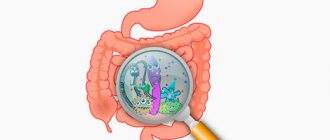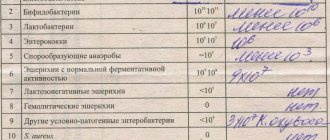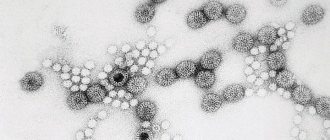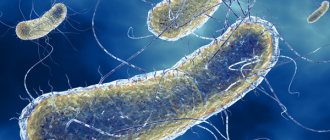Published: 11/09/2018 Updated: 04/15/2021
Acute viral intestinal infections (AVI) are similar in initial symptoms to acute respiratory infections or influenza: sore throat, fever, weakness. The first thing that comes to mind is that I have a cold! However, after some time, more unpleasant circumstances appear - severe nausea, vomiting and diarrhea, which is not easy to cope with. Many people mistakenly believe that they ate something wrong and got poisoned due to a “cold.” This is wrong.
The reason for the development of this scenario of events is the intestinal group of viruses - enteroviruses, noroviruses, rotoviruses. Self-medication in this case is not recommended, especially if the case concerns a child or an elderly person. What is important? Promptly perform the necessary tests and begin treatment!
Detailed description of the study
Intestinal infections caused by Shigella and Salmonella microorganisms are widespread. Bacteria Shigella spp. cause an infectious disease called shigellosis. Previously, the term “dysentery” was also common. Among Shigella spp. There are 4 main serotypes: S. sonnei, S. flexneri, S. dysenteriae and S. boydii.
Shigellosis is characterized by a fecal-oral transmission mechanism, but the route of infection varies depending on the serotype. For S.dysenteriae, the predominant route is the contact-household route, for S.flexneri and S.boydii - aquatic, for S.sonnei - food. The source of infection can be not only a person with clinical manifestations of shigellosis, but also an asymptomatic carrier.
Once in the digestive tract, Shigella releases toxins. They damage not only the intestines, but also harm the entire body. The incubation period depends on how many bacteria enter the intestines. Usually it is about 2-3 days. The onset of the disease can be acute, when fever, nausea, diarrhea and vomiting appear on the first day, or subacute, when abdominal pain and fever first occur, followed by vomiting and diarrhea. A characteristic sign of shigellosis is the presence of blood in the stool, frequent painful urge to defecate - tenesmus.
The severity of the disease may vary depending on the general health of the person and his age. In some cases, complications develop: the kidneys, cardiovascular system, and lungs are affected.
Salmonellosis is also a common intestinal infection. The causative agent of the disease in this case is bacteria of the genus Salmonella. Many serotypes of Salmonella have been identified, among which S. enterica, S. typhimurium, S. infantis, S. anatum and some others are pathogens for humans.
Salmonella is similar in its pathogenic properties to Shigella. They also produce toxins that cause inflammation in the digestive and other systems. The transmission of infection is based on the fecal-oral mechanism. Infection with Salmonella spp. most often occurs when eating food contaminated with microorganisms. Sources of infection are insufficiently heat-treated meat and dairy products, raw eggs, and confectionery products with cream.
Manifestations of salmonellosis include: abdominal pain, vomiting and diarrhea, as well as increased body temperature. Unlike shigellosis, blood in the stool and tenesmus are not typical for this infection.
It should be borne in mind that both of these infectious diseases can occur in an erased form, and the clinical picture itself does not always allow us to judge the causative agent of the infection. Along with this, acute intestinal infections of a bacterial nature require prompt administration of antimicrobial therapy to avoid systemic complications. Laboratory testing is required to clarify the diagnosis.
The basis for diagnosing bacterial intestinal infections is inoculating biomaterial (stool) on nutrient media. Detection of the growth of Salmonella or Shigella colonies will allow you to confirm the infection and select treatment.
Causative agents of intestinal infections
Feces are used as biological material for laboratory research. It is very important to properly prepare for the analysis so that its results are as informative as possible. You cannot donate biomaterial while taking antibiotics. Stool sampling should be carried out either before the start of antibacterial therapy or 14 days after its completion.
You cannot take biomaterial from diapers, after an enema, taking medications that affect intestinal motility, as well as feces with impurities of other biological fluids of the body.
You should take feces only after a natural bowel movement. Collecting biomaterial after an enema is strictly prohibited. The sample is collected on clean paper or a sterilized glass or plastic container. You can obtain a sterile container from our laboratory reception desk for free.
There is a special spatula for collecting feces. You need to collect at least half a teaspoon of biological material.
Feces must be donated only on the day of collection - collecting feces from the evening of the previous day is strictly prohibited.
All intestinal infections usually occur with similar symptoms, regardless of the pathogen. Using this analysis, you can find out as accurately as possible the origin of the pathogen that caused the disease and unpleasant symptoms. In acute intestinal infections, both viral and bacterial pathogens can be detected. These indicators in children under 3 years of age are 90% for viral agents and 10% for bacterial ones. And in adult patients, the proportion of viral pathogens is only 30%.
A referral for this study is issued by a patient with diarrheal syndrome, as well as for examination of persons in areas of group morbidity.
Decoding the analysis for intestinal infections
Reference values: negative.
Reasons for the positive result:
- the presence of DNA or RNA of the causative agent of acute intestinal infections; etiology depending on the type of pathogen identified (Shigella spp., E. coli (EIEC), Salmonella spp., Campylobacter spp., Adenovirus F, Rotavirus A, Norovirus (2nd genotype), Astrovirus).
References
- Pokrovsky, V.I., Pak, S.G., Briko, N.I. and others. Infectious diseases and epidemiology. Textbook. - M.: GEOTAR-Media, 2007. - 816 p.
- Yushchuk, N.D., Vengerov, Yu.Ya. Infectious diseases. National leadership. Brief edition. - M.: GEOTAR-Media, 2022. - 1056 p.
- Mazankova, L.N., Gorbunov, S.N. Diagnosis and treatment of acute intestinal infections in children. Methodological recommendations for doctors, 2012. - 93 p.
- Ejidokun, T. Principles and Practice Recommendations for the Public Health Management of Gastrointestinal Pathogens, 2022. - 85 p.
A comprehensive molecular genetic study that allows us to identify the genetic material of the most likely causative agents of acute intestinal infections in feces and establish the etiology of the disease.
Synonyms Russian
OKI, PCR (cal).
English synonyms
Acute intestinal infection screening; Bacterial and viral diarrhea screening, PCR, fecal samples.
Research method
Real-time polymerase chain reaction.
What biomaterial can be used for research?
Cal.
How to properly prepare for research?
- The study is recommended to be carried out before starting antibiotics and other antibacterial chemotherapy drugs.
- Avoid taking laxatives, administering rectal suppositories, oils, limit taking medications that affect intestinal motility (belladonna, pilocarpine, etc.) and the color of stool (iron, bismuth, barium sulfate) for 72 hours before stool collection.
General information about the study
Acute intestinal infections (AI) are a group of diseases caused by viruses, bacteria or parasites, which are characterized by a fecal-oral transmission mechanism. Common transmission factors for these infections are food, water, contaminated household items and dirty hands. The first symptoms appear several hours or days after infection; the onset is abrupt, with the appearance of frequent loose stools, vomiting, abdominal pain, and signs of intoxication (fever, chills, nausea). The disease can be group in nature and occur in several people who have consumed contaminated food or water.
According to official statistics, in Russia up to 65-67% of diseases in this group are acute intestinal infections of unspecified etiology. If the causative agent of the infection is unknown, the effectiveness of anti-epidemic measures is limited. The ratio of the frequency of detection of viral and bacterial pathogens varies at different ages: in children under 3 years of age, viral agents account for 80-90% of diseases, bacterial agents account for 10-20%; Among adult patients, the proportion of viral pathogens decreases to 30%.
Shigella species and Esherichia coli are gram-negative rod-shaped microorganisms from the Enterobacteriaceae family. The genus Shigella includes pathogenic bacteria S. dysenteriae, S. flexneri, S. boydii and S. sonnei, which are the causative agents of shigellosis (bacterial dysentery). Enteroinvasive E. coli (EIEC) are very close to Shigella, synthesize and secrete Shigella-like toxin, are able to penetrate the cells of the intestinal mucosa and destroy enterocytes, which leads to the formation of ulcerative defects in the intestinal mucosa. Enteroinvasive escherichiosis is responsible for a significant portion of cases of “bacteriologically unconfirmed dysentery,” especially in children.
Bacteria of the genus Salmonella belong to the Enterobacteriaceae family. S. typhi and S. parathyphi are the causative agents of typhoid fever and paratyphoid fever. There are many serovars of Salmonella species that can cause an infection in humans such as gastroenterocolitis, as well as cause nosocomial infections. Salmonellosis can occur in the form of an acute intestinal infection, severe generalized infection, or asymptomatic carriage. The final diagnosis is made only after isolation of the pathogen or detection of its DNA.
Campylobacter is one of the most difficult microorganisms to cultivate (which is required during the analysis). This is explained by their microaerophilicity and the possibility of suppressing their growth by the accompanying flora. The genus of Campylobacter includes both causative agents of acute infections (thermophilic species) and saprophytic and opportunistic species, which must be remembered when identifying these microorganisms in clinical material. The use of PCR-based kits to determine the thermophilic group of campylobacteria allows not only to avoid labor-intensive and high-cost bacteriological work, but also to clearly limit the detection of those species of campylobacteria that have an etiological connection with acute intestinal infection (C. jejuni, C. coli, C. lari, C. upsaliensis).
In accordance with foreign literature data, norovirus is the most common causative agent of outbreaks of acute respiratory infections of non-bacterial etiology. This feature is associated with a low infectious dose and high persistence in the environment. PCR is the “gold standard” in the clinical diagnosis of norovirus infections.
Despite their somewhat lower prevalence compared to rota- and noroviruses, astroviruses constitute a significant group of intestinal infections, which occur with colitis in a third of patients. Group A rotaviruses are the most common cause of sporadic acute respiratory infections in children, and DNA-containing adenovirus F (serotypes 40 and 41) often causes outbreaks of gastroenteritis in young children.
To identify and differentially diagnose intestinal infections, cultural and molecular genetic methods are used to study the genetic material of the pathogen in feces and determine the concentration of specific immunoglobulins in the blood. PCR has an advantage over cultural methods due to the rapid production of results, high specificity and sensitivity of the study. This analysis makes it possible to identify the causative agent of intestinal disease with 100% accuracy, and rapid diagnosis of acute intestinal infections helps to avoid unnecessary procedures and surgical interventions, start treatment in a timely manner and limit the source of infection.
What is the research used for?
- To establish the etiological factor of acute intestinal infection;
- for differential diagnosis of the causes of acute gastroenterocolitis (inflammation of the gastrointestinal tract).
When is the study scheduled?
- With symptoms of acute gastroenteritis, probably of infectious etiology (loose, frequent stools, vomiting, fever, abdominal pain);
- with simultaneous or sequential development of acute intestinal infections in several family members, in children in a children's institution or in patients in a hospital;
- if the development of a nosocomial intestinal infection is suspected (with exacerbation of symptoms of enterocolitis in a patient being treated for acute intestinal infections).
What do the results mean?
Reference values: negative.
Reasons for the positive result:
- the presence of DNA or RNA of the causative agent of acute intestinal infections; etiology depending on the type of pathogen identified (Shigella spp., E. coli (EIEC), Salmonella spp., Campylobacter spp., Adenovirus F, Rotavirus A, Norovirus (2nd genotype), Astrovirus).
Reasons for negative results:
- absence of infection with Shigella spp., E. coli (EIEC), Salmonella spp., Campylobacter spp., Adenovirus F, Rotavirus A, Norovirus (2nd genotype), Astrovirus.
Prevention of intestinal flu
There is no vaccine for intestinal viruses. Therefore, the only way to avoid infection and prevent further spread of the infection is to follow the rules of hygiene:
- Always wash your hands after returning from the street, the toilet, or traveling on public transport.
- Wash all vegetables and fruits (even bananas and kiwis) before eating.
- Drink only boiled and bottled water, not raw (!).
If someone in the house is sick:
- Carry out wet cleaning daily. Wipe all surfaces and objects that a sick person comes into contact with (door handles, plumbing fixtures, especially the toilet seat, children's potty). Viruses are resistant to alcohol and ordinary detergents, so use disinfectant and chlorine-containing household chemicals.
- Dishes, bed linen, and hand towels must be individual.
- Wash all clothes that may have traces of vomit or feces on them immediately at a temperature of at least 60°.
Be healthy!
Inflammatory bowel diseases
Inflammatory bowel disease (IBD) is a chronic inflammatory process involving the entire intestine or part of the gastrointestinal tract (GIT). This usually leads to abdominal pain and diarrhea, and sometimes extraintestinal symptoms may occur: inflammation of the joints, skin rashes, inflammatory eye lesions.
The causes of this pathology are still not precisely known, although the involvement of the immune system and genetic factors is assumed.
The main inflammatory bowel diseases are ulcerative colitis (UC) and Crohn's disease.
They also include collagenous and lymphocytic colitis, but they are usually considered separately from the main types of IBD.
The course of IBD can be long and debilitating; in addition, life-threatening complications sometimes occur: bleeding, the development of an oncological process, inflammation of the abdominal cavity due to intestinal contents entering it through a defect in the intestinal wall.
Drug therapy is often successful, leading to the disappearance of symptoms for a long time. If it is ineffective, surgical treatment is performed.
Synonyms Russian
IBD.
English synonyms
Inflammatory bowel disease, IBD.
Symptoms
Manifestations of the disease depend on the severity of the process and its location. In addition, there are periods of remission (complete disappearance of symptoms) that last for months or even years.
The most common symptoms of IBD are:
- chronic diarrhea with blood in the stool, sometimes mucus,
- abdominal pain, possibly cramping in nature,
- intestinal bleeding (more typical for Crohn's disease),
- feeling of incomplete bowel movement and false urge to defecate,
- anal fissures (characteristic of ulcerative colitis),
- fistulas (pathological passages connecting the intestine with the external environment or with another intestine in the wrong place; typical for Crohn's disease)
In addition, there are a number of extraintestinal symptoms:
- general weakness and malaise,
- temperature increase,
- loss of appetite and body weight,
- anemia due to bleeding and impaired iron absorption.
Sometimes joint pain, inflammatory eye lesions, red, bumpy, painful rashes appear on any part of the skin.
General information about the disease
Inflammatory bowel diseases are chronic, recurrent diseases that affect the gastrointestinal mucosa.
Currently, the cause of IBD is not completely known. They are believed to be mainly caused by:
- disorders in the immune system, leading to its increased activity and excessive production of antibodies (protective factors) against cells of the own mucous membrane,
- genetic factors, which is why people whose relatives had it are more susceptible to IBD.
Additionally, stress and dietary patterns may increase the risk of IBD.
The main forms of this pathology are ulcerative colitis and Crohn's disease. In ulcerative colitis, the pathological process is localized in the colon, the inflammation is continuous and affects only the upper layers of the mucous membrane, without penetrating deep into the tissue.
In Crohn's disease, any part of the gastrointestinal tract can be affected, from the oral cavity to the rectum; inflammation penetrates deep into the tissue and is characterized by segmental damage to the mucous membrane.
Chronic inflammation leads to impaired digestion and absorption of nutrients (malabsorption), as a result of which the level of microelements, glucose, protein, and vitamins in the blood decreases, which can cause depletion of the body.
Who is at risk?
- Persons whose relatives suffered from inflammatory bowel diseases.
- Young people under 30 years old.
- Smokers (smoking negatively affects the course of Crohn's disease, but quitting it can provoke its exacerbation).
- People who frequently take painkillers (non-steroidal anti-inflammatory drugs) such as ibuprofen, naproxen, aspirin.
- Residents of megacities.
Diagnostics
If you have symptoms of inflammatory bowel disease, especially frequent, loose, bloody stools or severe abdominal pain, you should consult a doctor.
The electrolyte composition of the blood may change, the level of total protein, glucose, and vitamins may decrease. In a general blood test, a decrease in hemoglobin is likely, indicating the development of anemia and/or an increase in the level of leukocytes, which indicates an infection.
A stool test is also used to detect digestive disorders and invisible amounts of blood in the stool.
The doctor may prescribe an X-ray or endoscopic examination of the intestine, the latter allows you to take a biopsy (a piece of intestinal mucosa) for examination under a microscope, which often helps to make a final diagnosis.
Treatment
The basis of treatment is the prescription of drugs that suppress the activity of the immune system. The synthesis of antibodies to the intestinal mucosa and the activity of inflammation are reduced.
If there is no effect of therapy, a consultation with a surgeon is necessary to decide on surgical treatment.
Recommended tests
- Complete blood count (without leukocyte formula and ESR)
- Serum albumin
- Total protein in whey
- Serum iron
- Potassium, sodium, chlorine in serum
- Serum calcium
- Plasma glucose
- Diagnosis of inflammatory bowel diseases (antibodies to intestinal goblet cells and pancreatic ducts)
- Coprogram
- Histological examination of biopsy diagnostic material
Treatment
The biggest mistake parents make is the desire to stop seemingly unwanted manifestations of the disease. But in the first hours this is strictly forbidden, because vomiting and diarrhea are a protective reaction of the body, which is trying to cleanse itself of toxins. Stopping cleaning will lead to even greater intoxication. It is important to constantly replenish the loss of fluid and mineral salts (potassium, sodium, calcium). You should ensure that your child drinks plenty of fluids. It is necessary to drink with special solutions. No juices or dairy! For acute intestinal infections, a saline solution is used: 1 teaspoon of table salt, 4 teaspoons of sugar and 1.5 teaspoons of baking soda per liter of water. You need to give your child 2-3 teaspoons of water every 3-5 minutes. If a child vomits, then it is necessary to drink in small portions so as not to provoke repeated attacks. It is best to give the child a warm drink (at body temperature): in this case, the absorption of liquid from the intestinal walls into the blood will occur as quickly as possible, which is now extremely important. Feeding a child who has an intestinal infection is extremely undesirable and one might even say that it is impossible. Hunger is the second cure in such a situation. The gastrointestinal tract is now affected, it has no time to digest food. When the child feels better and he still demands to eat (only in this case!), stick to the diet: light rice soup, oatmeal or rice porridge, low-fat cottage cheese or kefir, mashed potatoes with water. You can also make a puree from baked apples, steamed carrots, pumpkin, zucchini, grated apples and bananas. It is forbidden to give your child foods that cause gas or contain coarse fiber. And no sweets, fatty, spicy, salty or smoked foods. Portions should be small: it is better to feed the child often, but in fractions. Monitor your child's hygiene very carefully. Be especially careful about hand washing after using the toilet and before eating. Only a doctor can judge the advisability of prescribing antibiotics and other medications. Therefore, you should not self-medicate.
Deal with diarrhea!
If an adult or child has diarrhea, do not immediately reach for antibiotics. After all, intestinal infections can be viral and bacterial, and antibiotics are needed only in the second case, and in case of viral diarrhea, this is just a wasted blow to an already weakened body. Therefore, you first need to get tested and understand the origin of the infection.
As a rule, the fact that the infection is viral (it can be caused by adeno-, rota- and enteroviruses) can be indicated by a sudden and sharp onset of the disease, when a high temperature quickly rises, vomiting and loose stools begin. Typically, such diseases do not last long (3 days) and go away on their own, without treatment. All the patient needs is just plenty of fluid, rest, diet and intake of enterosorbents. But bacterial infections usually develop gradually, take longer and are more severe, and their treatment requires antibiotics.
This is no small thing
However, viral intestinal infections should not be taken too lightly. They are especially dangerous for older people suffering from cardiovascular problems, as well as for children under 5 years of age. In them, frequent diarrhea can cause rapid dehydration, which leads to disruption of the heart muscle and a high risk of death. Therefore, if there are more than 10 episodes of diarrhea per day or loose stools are accompanied by a high temperature (above 38.5 degrees), it is better to immediately call an ambulance. After all, diarrhea is the second cause of death in children after pneumonia
The most common cause of diarrhea in children under three years of age is rotavirus infection. Despite the existence of a vaccine against this disease, according to WHO, more than half a million babies die from it every year worldwide. Vaccination against rotavirus is not included in many national calendars and only parents who know about the dangers of rotavirus infection vaccinate their children. This contagious infectious disease primarily affects the stomach and intestines of the patient. As a rule, rotavirus infection (as with any viral diarrhea) is characterized by an acute onset. Usually, against the background of normal health, a sharp jump in temperature occurs, and other signs of ARVI appear (runny nose and sore throat). Then gastrointestinal manifestations occur: nausea, vomiting, loose, watery, copious stools without blood.
How can you get infected?
It’s easy to catch rotavirus, since this pathogen is found almost everywhere and is resistant to environmental conditions, so it spreads at a high speed. In addition, immunity to this disease is not very stable (vaccination protects against severe forms for several years), so you can get it many times throughout your life. There are several ways of transmitting the virus: through household contact (through unwashed hands or contaminated objects) and airborne droplets.
By the way, you can become infected with rotavirus not only from a sick person, but also from a virus carrier. As a rule, adults with strong immunity transmit rotavirus without knowing it, since they do not have any corresponding symptoms. But for others, nevertheless, they pose a great danger. So, children often become infected with this infection not from their peers in children’s groups, but from their own mothers and fathers.
Why are tests needed?
It is almost impossible to find out without tests whether viruses or bacteria caused diarrhea, so it is better to consult a doctor, especially if the patient does not feel better on the third day of the disease. But in the case when a child is sick, of course, you cannot wait three days. The doctor may prescribe broad-spectrum antibiotics, and if they are ineffective, he will recommend a bacterial culture of stool to determine the sensitivity of microbes to the antibiotic. This will help you choose the drug appropriately.
If you suspect a viral nature of diarrhea, you need to take blood tests to determine rotavirus RNA. By the way, among the 7 groups of rotaviruses, the most common pathogen is group A rotavirus (occurs in 90% of cases). The genetic material of this virus can also be detected in feces (by PCR-polymerase chain reaction). A stool test for rotavirus can confirm the diagnosis of rotavirus infection.
These studies are not relevant for choosing therapy, since the treatment of viral diarrhea is symptomatic, and besides, by the time the analysis is ready (after 3 days), the disease most often goes away on its own. But research will help identify the cause of diarrhea in children and adults. In addition, if rotavirus is suspected, it would not hurt to test all members of the family in which a small child is growing up, since adults can be carriers of the disease, which is extremely dangerous for children under 3 years of age. Finally, tests for rotavirus infection are needed to examine contact persons in kindergartens and schools for the purpose of early detection of the virus and timely initiation of treatment.
If there is a suspicion of a viral or bacterial intestinal infection, but it is not clear which infection is causing the symptoms, the optimal test would be an OKI test. This test allows you to analyze stool to determine the presence of rota-, noro- and adenoviruses, as well as bacteria - salmonella and shigella (the causative agents of salmonellosis and dysentery).
Types of viruses
Intestinal viruses are divided into several types:
- Rotaviruses. They belong to the Reoviridae family and provoke outbreaks of disease during the cold season. The virus causes severe diarrhea with dehydration, especially in children under three years of age. In some cases, urgent hospitalization and intensive rehydration therapy (restoring fluid balance in the body) are required.
- Noroviruses. It is believed that up to 50% of acute intestinal infections are caused by these viruses (family Caliciviridae). In children, noroviruses are the second most common cause of disease after rotaviruses. The virus was first identified in 1972. Clinical symptoms are similar to rotavirus infection. You can become infected not only through airborne droplets, but also through household contact, for example, through a handshake, a kiss, unwashed hands, any objects, toys used by an infected person or a carrier in the recovery stage. A person is contagious in the first two days from the moment of infection. But it may still be “dangerous” for some time, since eliminating the norovirus from the body can take up to two weeks. The first symptoms of the disease appear within 12-48 hours. Immunity is formed, but it is not stable; it lasts for about eight weeks. So you can get sick again if you don’t follow the rules of hygiene.
- Enteroviruses. Representatives of the family Picornaviridae. Most often, the pathogen attacks children, including those in the first year of life, as well as people with weakened immune systems. It is transmitted in the same way as other intestinal viruses.







